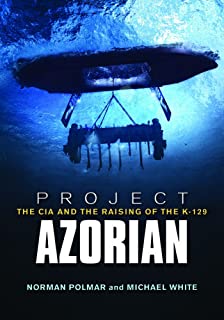 In 1969, the diesel-electric submarine K219 set sail from Kamchatka to take up its patrol station a few hundred miles off the coast of Hawaii. It was carrying nuclear tipped torpedoes and at least one nuclear tipped ballistic missile. Shortly after taking up its station, it sank. The Americans heard it all happen on their Sound Surveillance System ( SOSUS), their system of listening buoys. The USSR had no idea what happened toK219, or where it happened. The US knew a sub had sunk, and had a decent idea of where it was. This launched project Azorian. Thus begins one of the most bizarre tales in naval history. The submarine sank in 15,000 feet of water... far too deep for any submarine. The US sent the Halibut, a nuclear powered sub, which searched the sea floor with a towed camera system. That alone was a major accomplishment. They retrieved photos of the stricken submarine. The bottom of the sub was blown out. It would appear that one of its ballistic missiles had lit up accidently, sinking the submarine. Why it happened s still a mystery. The US wanted the Soviet sub and its nuclear warheads. The US approached Howard Hughes and together, they built a ship called the Glomar Explorer. It was seemingly a deep sea mining research vessel. In fact it was a mount for what would amounts to a giant hand or claw that was to be clandestinely lowered on a drilling rig pipes to the bottom of the sea, grab the forward section of K219, and raise it to the surface for collection and detailed inspection. And it worked! An amazing feat of engineering! Unfortunately, the submarine split in two while it was being raised and the US got much less than they had hoped. The Soviets denied any knowledge of the submarine and covered it up. The book is pretty dry. It contains a lot of naval detail that backs up the tale. The tale is like a James Bond story. There is speculation on why the submarine sank. It was most likely a mistake made by a crewman during a drill. It could also could be the case that the K219 was about to start world war three, but was thwarted by benevolent sailor. The whole story was kept secret for a decade or two.
0 Comments
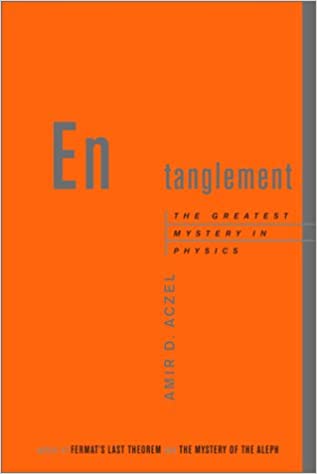 This book is about quantum mechanics and entanglement. You will know more about QM after reading it, but trust me, you will not understand it any better. It is too weird and there are no analogies in our macroscopic world that apply… not even causality. The book is a good history of the development of this crazy part of physics, from Newton and Young through Heisenberg, Bohr, Einstein and Bell. QM seems to be saying that two particles that are separated by great distance can, some how, instantly influence another. This seems to violate relativity (which it kind of does). Einstein rejected the QM model because it was proposing "spooky action at a distance". For most of the 20th century, no one knew who was right: Bohr, the champion of QM, or Einstein, the master of relativity. Einstein is famous for saying "god does not play dice with the universe". He was wrong and Bohr was right. The book spends quite some time on the infamous two slit experiment. Richard Feynman had this to say about the two slit experiment: "We choose to examine a phenomenon (the two slit experiment) that is impossible, absolutely impossible, to explain in any classical way. And which has in it the heart of quantum mechanics. In reality, it contains the only mystery." The ideas in this book are far too deep to explore in a short piece like this. So rather than trying to write notes about the contents, I am going to describe the famous two slit experiment. Newton showed that light was a wave using a prism. Waves display interference. Click the link to see water wave two-slit interference. Young's two slit experiment shined monochromatic light (light of one colour) through two vertical slits set a certain distance apart. When the light passes through the two slits and appears on a screen, it shows patterns of light and dark, aka "interference". Liight was a wave. Then Einstein came along and explained the photoelectric effect in which light is clearly acting like a particle (called a photon). Light is both a wave and a particle, and neither, at the same time! This is known as "wave-particle duality". Flash forward a few years. The experiment is refined. With modern tools, they can see where and when a single photon hits the detectors. Laser light is used to create the interference pattern. Billions of photons interfering with each other to create an interference pattern on the detector. So far, so good. Nothing odd is happening here. If we turn the brightness down, or in other words, fire fewer and fewer photons of light, we would expect to see interference pattern disappear because there will not be enough photons to interact with each other to create interference. In the extreme case, experimenters can fire one photon at a time, separated by as much time as desired. In this scenario, it is obvious that the photon must pass through one of the slits and, since it is alone, no interference can appear. But… it does! As each photon is fired, slowly over time, a diffraction pattern emerges! This makes no sense. The only way to explain this is to say that the photon goes through both slits at once and interferes with itself! That is three exclamation points in one paragraph. It gets stranger. If the experimenter makes any attempt to figure out which slits the photons go through, the pattern disappears. The reason for this is partly explained by what the word "look" means in this context. To "look" at a photon or any subatomic particle, we must bounce something off it. Doing this at the atomic level is like firing a bullet at a BB. If you hit the BB, you know where it was, but you now have no idea in which direction the BB is now travelling. To know more precisely where a particle is, you must hit it harder, and that act upsets the QM applecart. This is just a restatement of the Heisenberg Uncertainty Principle. QM effects are reliable enough to make your smart phone work, but only if you do not look too closely at the mechanisms. If you look, QM hides. No one has been able to explain this in terms people can understand, and no one has been able to find an exception to the rules. The remainder of the book discusses the weird world of entanglement., focusing on Bell's Theorem which ultimately defeated Einstein's world view. Dumb asses light Deepak Chopra like to read into QM some magical effect that binds us all together. I am tempted to call the "the Force". That is rubbish. It should be noted that entanglement does seem to work at infinite speed, but it cannot be used to communicate instantly over vast distances. Einstein is still right about that. 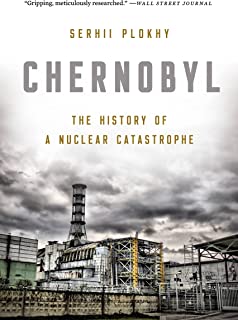 On April 26th, 1986, the Chernobyl nuclear reactor number four exploded. The explosion lifted a more than 200 ton "bio-shield" named Elina into the air, exposing the reactor's core. If you have seen the docudrama about Chernobyl, then you are already aware of much of the contents of this book. I wanted to read it to better understand the physics. What I got was a better understanding of how the worst nuclear disaster in history could have happened at all. The short answer is that the USSR was crumbling, inefficient, and corrupt. The USSR was most concerned about saving face, extolling Soviet science as the best in the world, and doing everything on the cheap. The result was the second major nuclear disaster in the USSR. A weapons-grade plutonium producing reactor in Siberia had a similar meltdown during the height of the cold war, but the USSR was able to keep it secret. In their arrogance, the USSR opted on a graphite moderated reactor design, rather than the water moderated design used everywhere else in the world. They eschewed the giant concrete containment vessels that Western eyes associate with nuclear reactors... thinking themselves too smart, and their reactor designs so safe, that they would never have an accident (again). The Soviets built 10 RBMK (in Russian: High Power Channel Reactor) reactors. These reactors were built by a system that had to deal with vendors who routinely supplied sub-standard goods. Seventy percent of one major vendor's goods were faulty. On one occasion, the Chernobyl plant out-performed its quota by 10%. This was accomplished in part by delaying routine maintenance operations. This sort of thing happened all the time. Here is my major take-away from the book: the Chernobyl accident lead directly to the collapse of the Soviet Union three years later. Ecological activism became associated with anti-nuclear and anti-Soviet feelings. Lithuania and, most importantly, Ukraine, wanted out. Ukraine got out on December 1, 1991. The explosion of reactor number four happened during a test of some of the reactor's emergency systems. The fatal test would, among other things, test the SCRAM (Safety Control Rods Activation Mechanism) functions. To do this, they wanted to simulate power losses on some equipment, such as safety equipment. If you think that sounds stupid, you are right. What happens next is complicated. The boron control rods are tipped with graphite. The boron slows the reaction down and graphite speeds it up. So as the rods go in, the power goes up, and then down. Another accelerating effect involving cavities full of steam (called the positive void effect) also increased power output. Power output went from 200 MWts to 30,000 MWts in just a few seconds. Then it exploded. What happens next was well covered in the docudrama. Chunks of red hot, and extremely radioactive, graphite were lying about on the ground. Fire fighters did not know what to make of them. For some who got too close, it would mean their death. Even remote controlled vehicles could not stand the radiation. Initially, the powers that be relied on dosimeter readings, which indicated a tolerable amount of radiation. They downplayed the severity based on that. But what they chose to ignore was that the numbers that the dosimeters were giving were the maximum they could register! When better meters were used, the true picture came into focus, namely that the radiation was well into the dangerous/lethal zone. Another problem was the water table. More Russian arrogance at work… they should have chosen a sight where ground water was not an issue. If the reactor got to the ground water, another explosion could be expected, along with radioactive water seeping into everything. In a heroic act, miners managed to tunnel under the reactor and freeze the ground solid with liquid nitrogen. They invoked a common Soviet saying: "Who, if not we?" All things considered, the story of Chernobyl could have been much worse. A whole town, many small villages, and thousands of acres of farm land was contaminated in Ukraine, Russia and Belarus. But all told, immediate deaths could be counted on one hand; and the final total, which includes cancers caused by radiation, and guesses on future death tolls is between 4,000 (from the UN) and 90,000 (from Green Peace) souls. I would like to think that the Chernobyl disaster had some positive impacts. As mentioned, it was the catalyst of the fall of the USSR (which Putin is trying to resurrect). No new RBMK reactors are being built. The original plan was shut these reactors down, but that idea was quickly modified when the practical realities were considered. People need power to live. The interior of the Chernobyl sarcophagus will be deadly to human life for 20,000 years. This was a very easy read. It is very well written. The author is aware of the avalanche of Russian names the book presents. He is careful to remind the reader of each players title and position whenever an obscure Russian re-enters the narrative. It has an excellent index. A note about radiation: The units have changed over the years. The old measures are the curie, rad and rem. They are replaced by the becquerel (GBq), gray (Gy), and sievert (Sv). They respectively measure the emitted radiation, the amount of radiation absorbed, and the biological damage done. Honor Before Glory; Scott McGaugh; 2016; Da Capo Press; 220 pgs, bibliography, notes, index29/12/2022 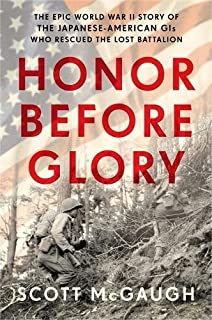 The 442 Infantry Regiment was, pound for pound (i.e. pro-rated for size), the best and most decorated fighting unit in the European Theatre. Two dozen Medal of Honors; Seven Presidential Unit Citations; 9,000 Purple Hearts; 6,000 Bronze and Silver Stars, and more. More than one medal per man! They gained fame for saving the WWII "Lost Battalion" of the 443 Infantry Regiment after they were surrounded by Germans for over a week. This book is about the rescue of the Lost Battalion and who did the rescuing. In addition to its battle record, the 442nd was unique in another way. The 442 was a segregated unit. If you are thinking they were black… close but no cigar. They were all Nisei, aka Japanese Americans, except for the officers, who were all white. All were volunteers, most from the Japanese concentration camps that were set up by the bigoted US government after Pearl Harbor. Many were from Hawaii. Canada segregated the entire Japanese population of British Columbia during the war, so we should be humble. Like the segregated black units, the Nisei were shit on by their country, but fought for it anyway. If you are a movie buff, there is the 1951 film about the 442nd's exploits called "Go For Broke" (the unofficial Regimental motto) starring Van Johnson. It is hard to find except on DVD. I recommend it. The Nisei had to beg to be allowed to fight. Finally, FDR made a speech where he described what a true American was, and how all Americans had the right to fight. He did not mention that those same Americans he was referring to were stripped of their most basic rights because of US bigotry. The 442 served in Italy with distinction. On October 24, 1944, the unit found itself in the Vosges Forest in France. In two months, the Battle of the Bulge would begin. The Vosges has Germany to the north east and Switzerland to the south east. The 441st Texas battalion was cut off and surrounded on hill 595 (595 is the hill's height above sea level). The Vosges is a very dense forest, featuring 45 degree hills and continuous cold rain and mist. The Germans were defending their homeland's border. They fought fiercely and bravely. Both sides were under-supplied, and neither side knew how poor off the other was. Both sides faced the same issues: miserable weather, foul water, little or no food for days, dwindling ammo supplies, and limited ability to treat wounded. For the Americans, one of the biggest risks was exploding trees. When hit with an artillery, trees splintered into a thousand flying knives. The 442nd was assigned the task of rescuing the 441st Texas Battalion. The German's were one thing that demand attention. Others include trench foot; acts of enormous courage and sacrifice; lack of everything (food, water, medicine, bandages etc); and friends dying every day as they fought to free the 441st. The biggest problem was resupply for the trapped Texans. Planes dropped gas tanks full of supplies that landed in enemy hands as often as they did friendly hands. Artillery was used to shell the Americans with supplies… a very dangerous procedure, as you might imagine. One soldier was killed by a can of cheese from a exploding resupply shell (the resupply shells had small charges in them). This book, like many others, documents the conditions of war… hell on Earth. There are many tear-inducing moments in the narrative. Perhaps the most galling thing about the battle was the actions of Major General John Dahlquist. He was an asshole of major proportions. Every few hours, he would get status information from the 441st and 442nd. Low on everything, fighting strength diminished, many untreated wounded etc. And every few hours, Dahlquist, the overall commander in the area, would give orders to do what he was just told was not possible to do. On several occasions, a junior officer flatly refused to carry out his orders, as they amounted to suicide for his men. The 442nd Nisei hated Dahlquist and respected their commander, Gordon Singles, for telling him to shove off. Shortly after the combat in the Vosges was over, Dahlquist assembled the 442nd for review. He was outraged that so few of them showed up... until he was informed that what he saw was all that was left of the 442nd. Dahlquist got in trouble later in the aftermath of the war for cozying up to Goering. IOW: he liked Germans better than he like Japanese Americans. Dahlquist's bigotry was baked into the army at the time. Some years later, Dahlquist attended a parade review of the 442nd. Dahlquist approached Singles in front of his men. Singles snapped to attention. Dahlquist held out his hand, suggesting that perhaps now they could bury the hatchet. Singles said nothing and held his salute until Dahlquist withdrew his hand and returned the salute. A perfect take-down. The 442nd remembered. Even after the war was over, things had not changed. Some west coast States tried to keep the Japanese from returning to their "homes" (in quotes, because their homes had been sold)! Many soldiers in the 442nd were put forward for medals. From the Congressional Medal of Honor to the Purple Heart, and everything in between. But after the war, most of the 442nd's medals were downgraded. This was blatant bigotry in action. It was not until Presidents Reagan and Clinton that some of these sins were redressed. Reagan paid reparations for stolen property and Clinton addressed the medals issue. Unfortunately, most of the major medal recipients were already dead. The last died about 10 years ago. 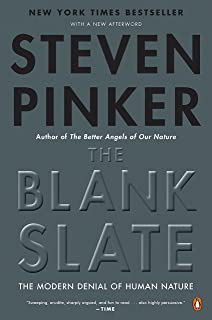 I often complain about books that lack a decent index. This one is not one of those. The Blank Slate refers to the idea that we are, when we are born, a tabula rasa (Latin for "clean slate"), with potential to become anything. It is a central tenet of most religions. Its pals are the Noble Savage and the Ghost in the Machine. To philosophers, they are known as empiricism, romanticism, and dualism. The three get along quite well. When one fails to capture an idea, the others can step in and save the day. Ensoulation, the moment when the soul enters the body, is wrapped up in it all too. Popes and dictators like the Blank Slate, as does religion. Nobility does not like it since they are born into nobility, presumably because they know they are inherently noble. Sociobilogy has become the Standard Social Science Model. Nature versus nurture is the debate. On one side is the Blank Slate (we can become anything we want), and on the other is genetic determinism ("I yam what I yam", as Popeye would say). This creates issues. For example, any hint that our genetics dominates who we are might lead to justifiable racism. If the Blank Slate dominates, then racism is a cultural issue that can be addressed. The answer throughout the book seems to be "It is shades of gray". You are not genetically fated, nor can you just shrug off your genetic heritage. Here are five ideas that represent the "cognitive revolution".
The rest of the book analyzes human behavior from various points of view, always landing, I think, on a useful compromise between the two extremes of analysis. Three recent major discoveries that superficially support the Blank Slate have added to the demise of the Blank Slate. First, the human genome was mapped. It has a surprisingly small number of genes (34,000 or so). The small number lent credence to the idea that anything complex could not be baked in. It also opened the door for the soul (fewer genes means more room for the Ghost in the Machine). Second, computer models of neural networks have led to new ideas about cognition. And the third is neural plasticity, which suggested that the brain is like clay and can be remodeled as needed. Pinker refutes these interpretations. One look at a new-born antelope that is up and running within minutes of its birth speaks volumes. That creature was not born with a Blank Slate. The Blank Slate cannot be blank for it it is, it could do nothing. Biologists like E. O. Wilson applied the ideas of Darwin and evolution to the Sociobiology of the human race and the shit hit the fan. Wilson was attacked for years with straw man arguments. The attackers claimed that Wilson's ideas justify Nazism and genocide. Their arguments are unscientific and stupid, even to a lay person like me. Remarkably, Stephen J. Gould made some awful arguments against Sociobiology. People's reactions seemed more visceral than logical. Needless to say, all this talk about evolution and brains processing information does not sit well with the "the church". Radical religion hates these ideas and fights them tooth and nail. A note about ensoulation. The Roman Catholic Church has been very clear: the soul enters the body at conception. Period. I have two close friends that are identical twins. Identical twins occur when a fertilized egg spontaneously splits, one to three days after conception. This is a problem. Now we have two people and only one soul! This problem can happen in reverse as well (two souls, only one egg). The church's ideas are not consistent with scientific reality. It took 300 years for the church to recognize that Galileo was right. It will take longer than that before the church ditches the idea of souls. After all, if you do not have a soul, they cannot threaten you with going to hell. It is December 13, 2022 as I write this. An article about an anti-abortion judge crossed my desk. It is a good illustration of Blank Slate reasoning. Judge Kacsmaryk spoke about the sexual revolution in 2015. He said: "… sought public affirmation of the lie that the human person is autonomous blobs of Silly Putty unconstrained by nature or biology, and that marriage, sexuality, gender identity, and even the unborn child must yield to the erotic desires of the liberated state." There is actually a chapter in Pinker's book called "Silly Putty"! There is a lot of angst over human nature. The next chapters of the book devote themselves to four issues: If people are innately different, discrimination is justified; If people are innately immoral, there is no hope; If people are simply a consequence of biology, then there is no free will; and; If people are just biological products, there is no meaning to life. I have had a great deal of disdain for clinical psychology over the years. The McMartin Preschool trial, the most expensive trial in US history, is a testament to the damage that can be done by mucking about with things you do not understand. McMartin was about psychologists who accused teachers of pedophilia based on statements from eager-to-please, prompted children. Pinker seems to share my disdain. But, over the last few decades, it would seem clinical psychology has matured and is now much more empirical in nature. A lot of data has been gathered, much from studies of separated twins and separated siblings, that have lead to some conclusions that drive your average parent nuts, until they understand what the conclusions actually mean. The issue circles around the debate between genetics (nature) and nurture (child rearing). For example: Insanity is hereditary… you get it from your kids. (Pinker's book is not without humor.) We are not all the same. Sex makes a big difference. It is generally true that males compete and females choose; males want quantity, females want quality. This is a natural outcome of evolution and the degree of investment each parent has in their offspring. Females are generally much more invested in their children than males, if for no other reason than the fact that sex takes minutes, but gestation takes nine months (for humans)… and that is often just the start. The remaining chapters of the book focus on the impact of the Blank Slate on Art, Politics, Gender, Violence and Children. The chapter on Children was quite interesting. Using three rules and a lot of relatively new empirical data, some surprising conclusions can be reached. The rules are:
Heritable traits become more so over time (e.g.: you get more like your parents as you get older). That is surprising. It is clear that the basic measurable traits of people are determined largely by their genes. Separated twins are remarkably similar to each other. Separated siblings less so, because they share less DNA. There is little a parent can do to change this. This does not mean that there is no such thing as "good parenting", just that good parenting is not going to turn a natural introvert into an extrovert. This book was a long read, but worth it. It covers a lot of ground. This is hardly surprising since human nature is so complex. The general sense I had was that Pinker's analyses always seems to land in about the same spot that my instincts would land me. Of course, he gets there through strong arguments. The issues raised by human nature get a lot of people really riled up (IMHO… mostly religious nuts). So much so that they fight back with a barrage of straw man arguments that seem to never want to die. When you say "some", they hear "all", and have a fit. When you say "may", they hear "must", and have a fit. You do not need to understand statistics and probabilities to understand Pinker's arguments. You should have a reasonable understanding of what correlation coefficients (CCs) are and what they mean. The short version is this: Imagine you are watching two stocks. A CC of zero between the two stocks is saying that the stocks are unrelated. A CC of 1 is perfect correlation: When one stock goes up, so does the other, in lock step. A CC of -1 means when one stock goes up, the other goes down. Any other value means that sometimes one stock will go up and the other does not, with a certain probability. My philosopher friend Dale Beyerstein has read the book and my comments. I have made some small changes to my essay based on them. I thought the following from him was worth including: "Second, a substantive argument between you, me and Pinker: I think that religious types who blabber soul talk (no, they’re not Black!) are less are less driven by the blank slate hypothesis than Pinker or you argue. Yes, many think they need the blank slate idea to say that you, as essentially a soul, can choose anything you want (innate parts of the brain won’t stop you). But the real driver is their need for the free will defence so they can blame us rather than God for evil. There’s nothing stopping them from a “middle ground” position that holds that much of our behaviour is hard wired, but the important part of the soul that we use to choose right or wrong transcends the parts that are hard wired. In fact, many fire and brimstone preachers bang on and on about how we (our souls) must use our reason (in the soul) to transcend our bodily pleasures (sex!) that are so evil. In other words, religious types have less need for the blank slate than ----- Studies (substitute ‘Women’s’, ‘Black’, ‘Fat’, &c.) people in universities." Aside on Logical Fallacies There are many, many logical fallacies (more than 100). You should learn to recognize some of the big ones. Google the "argument from ignorance"; the "straw man" (see below); and confirmation bias as a start. If you have more time, just Google "logical fallacies". Straw man arguments are a common logical fallacy. Since I mentioned them in this text, here is an example of a straw man argument. You say "I believe in evolution." Your opponent replies "So you think we descended from apes!" The opponent is making a straw man argument by attacking you for something you did not say, nor even believe (the straw man). (We are not descended from apes. Mankind and apes share a common ancestor.) 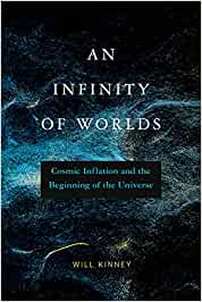 This book deals with the biggest questions of all about the biggest thing of them all… the entire universe of universes, or if you prefer: life, the universe and everything. These write-ups are really just my notes on what I have read. In many cases, the concepts are so large that my notes cannot do them justice and you must read the original source. This just such a case. This book contains some very large, deep ideas that I do not really understand and my notes cannot adequately reflect. This book's index is quite poor. A pet peeve of mine. Some basics the book discusses:
At this point, the book lays out a cosmic timeline beginning from a very hot and dense start 13.7 billion years ago, till now. Time starts in the Planck Era: from 10 to the -43 seconds to 10 to the -32 seconds. It goes on from there to 6 billion years ago when matter became less dense than energy and cosmic growth stopped decelerating and started accelerating. Which brings us to today. It is very hard to summarize a book that deals largely in abstract ideas, but here goes.
Another interesting idea about time is discussed. We see an infinite future, but a finite past. This is asymmetric. But if you use a logarithmic clock, time appears infinite in both directions. The descriptions of the many universe hypothesis is fun and intriguing, but as the author points out, these ideas are not scientific in that they are unfalsifiable. The title of the book comes from Giordano Bruno who said, shortly before he was burned to death for heresy: "God is infinite so his universe must be too… He is glorified not in one, but in countless suns, not a single earth , a single world, but in a thousand thousand, I say an infinity of worlds." No discussion of the universe and how it came about is complete without mentioning the anthropic principle. One way to look at the multiverse is as a beer with many bubbles. Each bubble is a universe, possibly with its own physics laws. The multiverse, as implied by inflation, also addresses the fine tuning argument (the idea that the universe was made just for us, or vice versa). In its simplest form, the anthropic principle is basically a tautology. The universe is what it is because we are here to observe it. I.e.: the universe implies us, and we imply the universe that made us. There are three main objections to the anthropic principle. 1) It is not scientific because we are cut off from the other bubbles. 2) The anthropic principle does not say what parameters in each universe can change, and which cannot. 3) The idea is based on a narrow interpretation of "life" This book is very recent so it should represent our best ideas of how it all came to be. These are literally the largest ideas that the human mind has ever contemplated. Five thousand years ago, somebody speculated that we were super-duper special, and that we, and everything we see, was all created for us by a benevolent god. That idea is forgivable and a load of rubbish. As we have grown in knowledge, our specialness has all but disappeared. I find it utterly remarkable that we live in a time when we can ask these types questions and actually get answers. Of course, most of those answers are negatives, often in the form of "close, but no cigar". The good news it that we are getting new data every day (e.g.: the James Webb telescope, CERN, LIGO, COBE, Chandra etc)), , and these data underscore our ignorance and drive us forward.  This a graphic novel. I have some interest in WWII, The story is about the Jewish Holocaust in Poland. The Jews are mice, the NAZIss cats. It is an interesting and engrossing tale of the horrors that the Jews suffered in NAZI Poland, and the lengths that the few who survived had to go just to get stay alive. As I write this in September 2022, this book was banned in several high schools in the USA. History of Warfare, A; John Keegan; 1993; Vintage Books; 393 pgs; References, Bibliography, Index18/8/2022 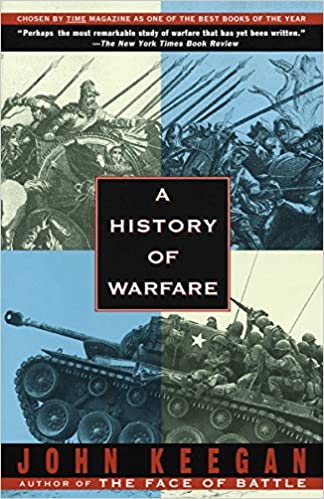 This is another book that cannot be summarized. It is long, uses a small font, and is information dense. Since human history and war cannot be separated, you can view this book as a history of humanity through the lens of war. The book opens and closes with Clausewitz. Clausewitz was a well known theorist about war and he argued famously that war was an extension of politics by other means. This book disagrees. Keegan points out early that wars are often fought over religious issues, and that Muhammad, unlike Christ, was a man of violence who preached jihad. Islam is divided over two caliphs (successors to Muhammad). They disagree on who is in charge and the basic aims of Islam, which is often religion at knifepoint. When guns were introduced to the battle field, many thought them unworthy of a soldier. In fact, Japan was so appalled at the idea that a common man could get a gun and kill man of high stature that they banned guns outright in order to perpetuate their close quarter combat military society. That all changed when the US sailed a gun ship into Tokyo harbor. Throughout history, war and technology moved hand in hand. With each new weapon came new tactics and new goals. The history of war is the history of empires and peoples… and there have been a lot of them through the ages. I had never heard of many of them, such as the Yanomamo of Peru: they were called "the fierce people" and were known for stylistic forms of ritual combat. War as we know it started with the invention of the bow and arrow (man's deadliest innovation to date) . The bow is a simple machine used to store muscle energy as mechanical energy and quickly release it. The bow was a true stand-off weapon... a game changer. Later, the composite bow was invented. These bows shot arrows further and faster, were much smaller than their predecessors, and could be wielded easily from horseback. . The first written history of war comes from Sumerians wall reliefs. Sumer was the land between the Tigris and Euphrates rivers around 5,000 years ago. The next innovation was the chariot. One may wonder why the Egyptians et al did not ride horses into battle. Horses have changed a lot due to selective breeding. Five thousand years ago, horses were small. They were well muscled in the rear but could not carry much weight on their forelimbs. This meant that a rider had to sit way back on the horse, making control difficult. But horses were good at pulling things, like a chariot. Later in history, the chariot was abandoned for the mounted cavalry soldier. Fortifications are discussed at some length. Fiction has made much of siege engines vs. fortifications. In reality, fortifications nearly always won out in a siege... until the age of gunpowder. Much is made of the clash between the nomadic horse peoples of the steppe (e.g. Mongols) and the settlers and farmers of cities and towns. There really was no way for them to coexist as they both competed for the same resources. Another group of well known raiders, the Vikings, used ships rather than horses. The book also goes into depth on armies: how they are formed, manned, fed, organized etc. Armies are built in many ways: through enslavement, conscription, and through volunteers who are rewarded in some way, such as citizenship. Rome was built that way and Rome had the first body of professional fighting officers in history. The introduction of iron was another game changer. Iron was strong, but very heavy, so most armor remained made of bronze. Cannons of bronze were supplanted by larger cannons of iron. Gunpowder allowed iron shots to fly horizontally which allowed cannons to undermine defensive fortifications. Siege engine shots were lobbed and generally dealt ineffective glancing blows. There is so much information in this book that it is best used as a reference work. Subsequent chapters discuss logistics and supplies and, of course, the modern wars that shaped our world: The US Civil War, the French Revolution, WWI and WWII, the introduction of nuclear weapons, and so on.  Most Canadians have never heard of Ortona, much less the Battle of Ortona (December, 1943). It was a relatively small operation compared to other primarily Canadian battles such as Hong Kong, Juno Beach on D-Day, the Battle of the Scheldt (12,000 casualties), and Dieppe. But Ortona was a costly Canadian battle for its size. Canada lost at the Battle of Hong Kong, and Dieppe. It won at the Scheldt, and took Juno Beach with only a few casualties. And it won at Ortona. That the German's would lose was a forgone conclusion, but they would make Canada pay dearly over three bloody weeks. Ortona is a small town at just about the same latitude as Rome, on the east cost of Italy. The east coast of Italy is very rugged and Ortona is the Italy's only deep water port on that coast… hence its strategic importance. Even so, the port was tiny and only capable of handling one or two ships at a time. Port or no port, Ortona had to be taken as the allies moved north up the Italian boot. As mentioned, Ortona was an almost all Canuck operation. An Indian division was there as well. The Seaforth Highlanders, one of the divisions that fought at Ortona, was raised largely from southern British Columbia. The book has a glossary which was helpful. For example, I had to look up "PPCLI" several times before I memorized its meaning, Specifically the Princess Patricia Canadian Light Infantry (obvious, right?). The fighting around Ortona was savage. Canadians were asked to attack dug in positions over and over. Creeping barrages helped when they did not land on friendly troops. Mud was everywhere. It bogged down tanks and made progress on foot exhausting. On the up side, if a mortar shell lands in the mud, it detonates late and the troops were largely protected from shrapnel. Mortars killed more soldiers on both sides than any other weapon. Germans fought dirty. On several occasions, German soldiers would surrender under a white flag, only to drop the flag and attack using hidden weapons when the time was right. They booby trapped everything as they withdrew. The combat pros knew the things to avoid, but green troops might pick up a souvenir luger that was attached to a bomb. Fun fact: One young lieutenant named Farley Mowat shows up in the story of Ortona. This book is a about a battle. The battle raged back and forth, often over the same patch of ground. The book details all these movements, but it also consists of short, often personal, stories about soldiers of all ranks. In many cases, their stories end in death. For example, it was most difficult to read about a short passage about a squad of reinforcements arriving on scene. The town of Ortona was largely in Canadian hands, but the Germans were fighting as they retreated and they knew the ranges to every point in town. Green, undertrained replacement troops were not unusual in battles that chewed through people at such a huge rate. A green officer lead a troop of about twenty fresh soldiers into Ortona. He marched them straight down a main street in parade fashion towards the Canadian front! The Germans dropped a motor round directly on the new squad, killing half of them. None of the fatally injured had ever seen combat. In another brief anecdote, a new under-trained green soldier arrived at the front and was given several type 36 hand grenades. The type 36 is the classic American "pineapple" hand grenade that you see in the movies all the time. He had to ask his sergeant what they were! The details of the battle are not important, but the sacrifices made by our fellow Canadians are. A typical day in the battle would consist of waking up at the crack of dawn in a cold, wet, fox hole. That would be followed by cold rations. Most days would have some action.... Perhaps an attempt to take or re-take some small house to be used as an HQ. A counter-attack would follow. If you were not fighting Germans, you were fighting mud, and getting sniped at, as you tried to move equipment and personnel about the battlefield. Artillery, machine guns and mortars were both side's weapons of choice. If you were lucky, you got a shrapnel wound that would have you moved to the rear, or even home. If you were not lucky, and you did not fall victim to battle fatigue (PTSD today), you might get shot and die in some filthy ditch. If you died on a road used by tanks, your body would likely be crushed until it was unrecognizable. By the end of the 1943, Ortona was in Canadian hands. 2,300 casualties; 500 killed. 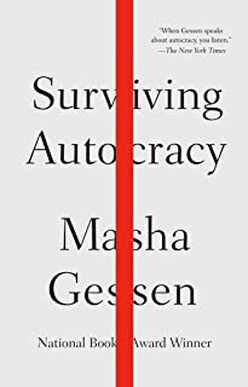 Another book with no index! This really annoys me. For a book like this, just indexing the proper names of people and places would take all of a day, and would help a lot. The book has a lengthy table of contents which makes up for it a little. Masha Gessen is a Russian born, gay, trans, activist and critic of Putin. This book should be taken seriously, but I feel that for many, it will be seen as a testament to the bleeding obvious… namely that Trump, Putin, dictators, and dictator wanna-bes around the world, are all taking their cues from the same playbook. This book tries to illustrate this fact. The book consists of 22 short, roughly chronological, chapters. It is a very fast read. For those that have followed Trump history, this book is an analysis of Trump sins… sins that seemingly go on forever and are never challenged.
Betsy DeVos, Commerce Secretary Wilbur Ross, Rex Tillerson, Mick Mulvaney, Jared Kushner, Ryan Zinke, Scott Pruitt, Tom Price, and David Shulkin were separately accused of stealing millions for themselves. Trump ran the most corrupt administration in US history... by far. He surrounded himself with crooks, yes-men, and people who have a loose grip on their principles. When those people compromised themselves just once, they were Trump property. When Erdogan thugs beat up American protestors at the White House, Trump and the White House did nothing. Professional courtesy perhaps? Kavanaugh was put on the Supreme Court in the closest vote ever (51 to 50), despite credible sexual assault accusations from Blasey Ford. Eighty-three complaints were filed against Kavanaugh during the hearing. All were subsequently dismissed! Why? Because it was too late. He was now out of reach on the Supreme Court! Certainly one way to get power is hire an AG who is in the bag. Trump got that with Barr. Barr, like Trump, lied all the time, but as always, without consequence. Language has taken a beating under Trumpism. Everything is either "terrific" or "treason". Trump whined endlessly about "witch hunts" while he was in power, without realizing that witch hunts are only conducted by those in power. "Fake news" is an oxymoron. Is it fake, or news? It cannot be both. Trump and Putin use the same tactic: accuse the accuser of doing the same crime. They are the very fountain from which "fake news" springs. Gessen points out the similarities between Trumpism and Post Modernism (PM). Few people know what PM is, in part because it is hard to define. The BC Skeptics, of which I was a part, held a meeting at SFU where the topic was Post Modernism. The presenter read a passage from a PM magazine. The text was on an overhead projector (remember those?) so the entire audience could read it and study it. Some of the smartest people I know were in that room and no one could offer up a clue as to what it meant. PM basically says that all past events are just stories, and stories are entirely subjective. There are no facts, just stories. PM got punked one day. Alan Sokal wrote an essay for publication in the largest PM magazine of the day. It was published. Then the author admitted he had merely written a paper in the style of PM and that was utterly devoid of insight. He deliberately contradicted himself several times. In other words, it was gibberish, but it was published gibberish. PM seemed to me to disappear (it just fell off my radar), but my philosopher friend Dale Beyerstein assures me it is alive and well. Case in point: Who can forget Kelly Anne Conway and her "alternate facts"? PM statements are designed to sound deep and contemplative, when, in reality, they are shallow and rambling. A typical PM essay is basically just word salad, and if that doesn't remind you of virtually every Trump speech, you haven't been paying attention. This is not to say that Trump uses PM on purpose. He is not that smart. But his speeches, especially when he goes off script, are little more than rambling, aimless, self-contradictory examples of verbal diarrhea. Trump even lies about the weather. The one thing in the world most people can agree upon is the weather, and Trump lies about it. Trump lied about the weather at his inauguration, saying it did not rain. Thousands of open umbrellas beg to differ. He also lied about the path of a storm, which he had changed with a Sharpie. He did not lie about a suggestion to use a nuke to stop a hurricane. He was just too stupid to know how stupid what he just said really was. On his road to becoming a despot, Trump referred to the press as "the enemy of the people". Stalin would be proud. The press does have some accountability in all this. In their zeal to appear neutral, they are automatically taking sides… namely, the autocrats side. Autocrats want language to be so loose that nothing that anyone says can be called a lie. This is very close to the George Costanza defense: "If you believe it when you say it, is it still a lie?" The answer to this must be "yes". In addition to the Hitler-esque Big Lie, another major authoritarian tactic is to separate "us" from "them". Recall the Jewish threat to NAZI Germany and the "caravans" that were going to destroy America? The people at the Mexican border come every year, like the tide, for their own reasons. One of those reasons is the international legal right to apply for asylum. Trump treated them all like animals, and literally called them that too. To be fair, both sides use language that can divide us when they speak of African Americans, or Muslim Americans, or even women. Unfortunately, this use of language is fuel for the fires on both sides. The only way to defeat this prejudice in America is to always emphasize, first and foremost, that all American citizens are equally American. I am a student of World War Two and the parallels between Hitler and Trump are very scary. It seems that he got more Hitler-ish every year he was in power. Gessen argues that all of these changes are signs of encroaching authoritarianism. The US likes to think of itself as the world's greatest democracy. Americans crow about rights and freedoms constantly while members of one party secretly try to restrict the rights and freedoms of their fellow citizens, all while knowingly allowing a criminally stupid pathological liar to be their president. It can happen again. |
AuthorLee Moller is a life-long skeptic and atheist and the author of The God Con. Archives
May 2024
Categories
All
|
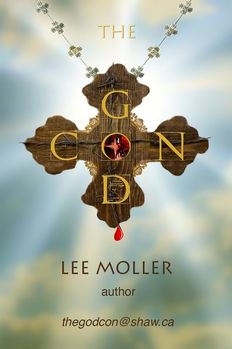
 RSS Feed
RSS Feed